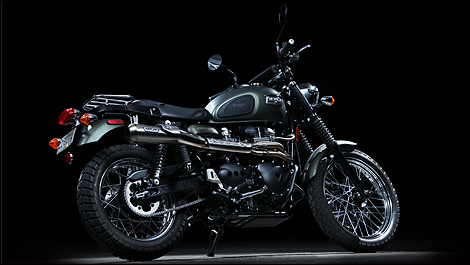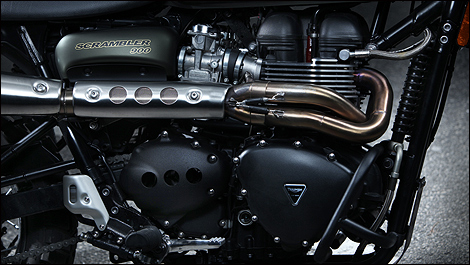A legend model from the sixties, the
Scrambler is part of a popular neo-retro family that sells very well at Triumph. We took a ride in
Daytona during Bike Week 2010 and, to tell you the truth, I definitely did not expect it to be that much fun to ride on the road.
 |
| The 2010 Triumph Scrambler will bring you all the way back to the ‘60s, when extra suspension travel for off road riding was limited to a couple of inches, and the exhaust system was placed high up to protect it from rocks and major damage in case of a fall, burned calf be damned. (Photo: Philippe Champoux/Moto123.com) |
The arrival en masse of Japanese bikes in the early ‘70s, with their electric starter and unprecedented levels of quality, essentially killed the English motorcycle industry, which was weighed down by old engine designs and electrics, questionable-grade metals, and worn out and obsolete pre-war production machinery.
John Bloor rescued the classic British brand and gave it a new life with all new models coming out in 1991. Today, Triumph is enjoying hit after hit thanks to a growing product line, with star quality models such as the Daytona 675 and Street Triple, several 1,050-cc Triples, plus the full neo-retro family for the ever-present nostalgia market.
Time machine
The Scrambler (The name given to what became Motocross by the Brits when they invented the sport in the late ‘40s) brings enthusiasts back to the ‘50s-‘60s and the Steve McQueen era with a more reliable, more capable and higher-quality motorcycle.
Featuring a narrow, post-WWII style seat, army-inspired Matte Khaki Green paint, close-to-knobby tires, fork gaiters and high-mounted, full-length dual exhaust pipes, the Scrambler looks like it belongs in a museum, at least until you see the front disc brake, the fuel injection wires on the “carbs”, and the high build-quality of the machine.
Lovely twin
Boasting a 270-degree firing interval, the parallel twin-cylinder of this Triumph is almost vibration-free. The injector bodies replicate the look of period Amal carburetors, which were impossible to keep properly set up for more than an hour, and conceal the basic yet very effective electronic injection system (you still have to use a manual choke for cold starts).
 |
| This blacked out version of the current vertical twin shows a clean design that evokes the look of the period engine, complete with fake Amal carburetters (The English spelling) that house the fuel injection system. (Photo: Philippe Champoux/Moto123.com) |

